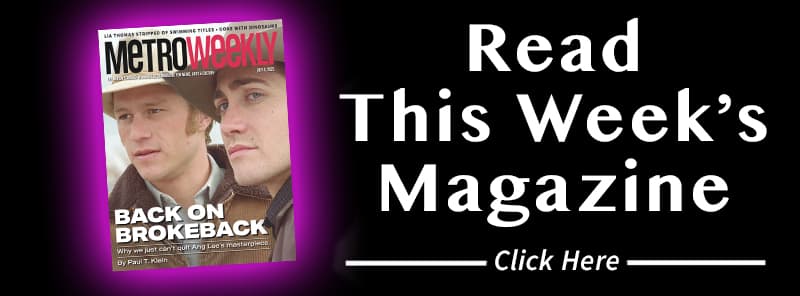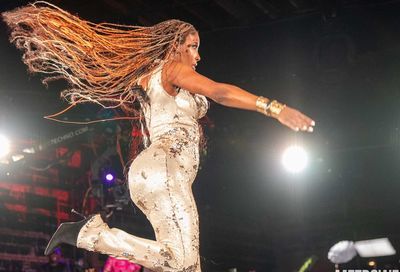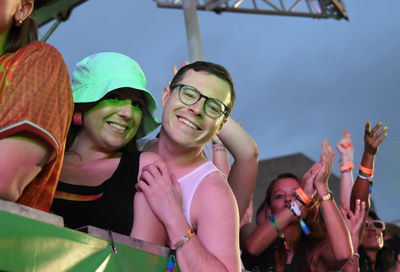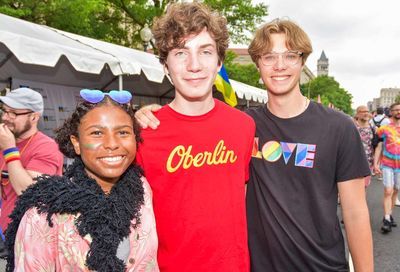12 Vintage Gay Adult Films Everyone Should See
Charting an odyssey of classic gay erotica, from Arthur J. Bressan, Jr.'s "Passing Strangers" to Wakefield Poole's "Boys in the Sand"

At some point during the quarantine, a well-curated adult entertainment website approached me, offering access to peruse their voluminous catalog. Perhaps there are those who’d decline or scoff at the opportunity. I dove in.
I didn’t just watch porn all summer, of course, but I watched more porn than usual. I also worked from home, at seemingly all hours, and tried to keep up with the world’s deluge of conflict and disruption. I mourned a death in the family, along with the deaths of many I didn’t know. I masked and distanced, marched and protested, hiked through a forest and laid on a beach.
The journey down the virtual video aisles of streaming platform PinkLabelTV began with a message from Jenni Olson, filmmaker, film historian, and co-director of the Bressan Project. For several years, Olson and the Bressan Project have worked to restore the films of pioneering gay filmmaker Arthur J. Bressan, Jr., including his landmark 1978 documentary Gay USA, chronicling the LGBTQ rights movement, and the wrenching 1985 drama Buddies, the first feature film to tackle the AIDS crisis.
Bressan himself succumbed to complications related to AIDS in 1987, following a prolific period in which the native New Yorker directed ten films in ten years. Two of them, Passing Strangers and Forbidden Letters, represent the plot-driven gay male erotica Bressan is better known for, and are the latest of his films to be restored by the Bressan Project. As of this August, both are available exclusively on PinkLabelTV, either streaming on-demand or with a PinkLabelTV PLUS subscription.
Founded in 2013 by queer feminist producer and director Shine Louise Houston, the PinkLabel platform is a treasure trove of indie adult entertainment, with diverse titles grouped into several appealing channels. Practically all genders and tastes are celebrated in a collection spanning decades, up to some brand-new releases. Lured, however, by the men, the mood, and the attitude of the sexually liberated ’70s and ’80s, I stuck with the PinkLabelTV Classics, billed as “vintage adult film from the silver and golden age of porn.” Bressan’s work was a highlight of my trip back in time, but Passing Strangers and Forbidden Letters were just the beginning.

Passing Strangers (1974)
Bressan has the audacity to open Passing Strangers, one of the few sexually explicit gay indies of the ’70s, with a grainy scene of straight sex — revealed to be playing onscreen at a porn theater. Portraying the projectionist that’s running the flick, Bressan proceeds to trash it for a good laugh, ragging on what passes for standard in the XXX industry. “Washed-out color, shitty prints, lousy soundtracks.” The rant provides a smooth setup for Strangers to exceed that standard, which it does as a piece of filmmaking and same-sex romance that just happens to feature plentiful nudity, anal, oral, and orgasms.
In brilliant black-and-white, the film follows tousle-haired 18-year old Robert (Robert Adams) and 28-year old Tom (Robert Carnagey) around the streets of San Francisco. Stepping slowly out of the proverbial closet, student Robert ducks inside an adult magazine shop outfitted with private, curtained movie booths. Alone in his parents’ house, he fantasizes being the center of a frolicking sex party, and getting off solo, surrounded by his admirers. Meanwhile, Tom cruises Polk Street in the Castro, bouncing between the bars and the baths, including the city’s iconic gay bar the Stud, in its original location. (During the current pandemic, the Stud actually closed, possibly for good.) Real locations, many of them gone but not forgotten, emphasize these vintage adult films’ value as multi-faceted records of queer lives, history, and culture.

After Robert responds to a Walt Whitman-quoting classified ad placed by Tom in the Berkeley Barb, the two court each other through letters (voiced by other actors — Edward Guthmann as Tom, and Bob Middleton as Robert). When they finally meet face-to-face, the film switches to gorgeously restored color, capturing their romance as it blossoms into outdoor sex on Angel Island overlooking the Bay. Although Adams and Carnagey are enthusiastic performers, Adams tends towards a pained expression when not in the midst of hardcore ecstasy. Their chemistry is more sweet than scintillating.
Still, the film lives up to the implied promise of the first scene’s catty critique, delivering lush color and strong composition. The dynamic soundtrack shifts from Moog synthesizer over sex scenes, to groovy guitar rock, to composer Jeff Olmstead’s keyboard score as the couple bikes through a sunny Sunday montage. And the voice actors, including Jerry Johnson as the projectionist Bressan plays onscreen, are at least as expressive as Adams and Carnagey.
To the movie’s credit, the leads fit the bill as two regular guys looking for love, as opposed to idealized porn stars. Theirs is a relatable romance, if overshadowed now by the light of early ’70s nostalgia. Indeed, the era’s history and expression come together beautifully near the film’s finale, as the lovebirds march in the actual Gay Freedom Day Parade of 1974. In the end, love and sex, and pride and celebration go hand in hand.
Forbidden Letters (1979)
Bressan’s long-unseen gay love story Forbidden Letters originally blazed a trail from arthouse cinemas to its international premiere at the 1980 Berlin Film Festival. More rawly sexual than Passing Strangers, the film is driven by a more suspenseful and involving premise. Dancing again between black-and-white and color cinematography, Bresson unfolds the tale of separated lovers Larry (Passing Strangers star Robert Adams) and Richard (Richard Locke), poised to reunite once mustachioed daddy Richard is released from prison. Until that day, Larry doesn’t wait idly for his man to come home, but rather calms his worries with a series of hookups, anonymous encounters, flashbacks, and fantasies.
Adams offers another blank-faced performance, although Bressan works around the actor’s limitations by handing most onscreen dialogue to costar Victoria Young, playing the couple’s friend, Iris, a tarot-reading happy hooker. Iris advises glum, young Larry to “get out, cruise, go to a movie, do something a little kinky. See a porno flick, get hot, take a Quaalude, sleaze around.” Like a Warhol superstar, but sober, Young injects humor and playfulness, counteracting the earnest folk-pop tunes laid over the man-on-man(-on-man) action. The movie depicts Larry and Richard’s idyllic life together, before prison, via an evocative sequence of still photos, also scored to earnest folk-pop. The one major musical diversion from the ersatz-John Denver sound comes with a trip to the crowded disco Cabaret on a glittering Halloween night.

Yet, even with all the partying, lovemaking, hookups, solos, and threesomes, the prevailing atmosphere is purely romantic. Adams and Locke generate heat in fits and starts, but their sex scenes are stiff and awkward. Rather, the characters’ loving commitment to each other makes a stronger impression than the hardcore action. As Larry writes to his beloved in prison — in letters he’s afraid to send lest he out Richard as gay — he had been searching for the special touch of a man to fill a hole in his life. He found that special sense of belonging with Richard, a bliss of “love, laughter, crashing waves, and sunsets.” And not even prison could tear them apart.
Un Chant D’Amour (1950)
Prison brings two stray souls together in Jean Genet’s classic featurette, Un Chant D’Amour (Song of Love), a film banned in France upon its release and censored in the U.S. and elsewhere. Two prisoners in adjacent cells communicate by knocking on the wall between them. The barrier trembles at their yearning touch. Through a tiny hole in the wall, they use a straw to pass cigarette smoke from mouth to mouth. The sensuality is nearly palpable, amplified by the lack of sound or dialogue.
The only film ever directed by the famed French writer (a petty thief in his youth), Un Chant D’Amour simmers with sexual tension stirred by the caged would-be lovers and the prison guard who gets off on peeking in on them in various states of undress and arousal. While subtle enough to properly engage the imagination, Genet’s film is strikingly explicit for a 1950 release. The guard enjoys a peep show of dancing hard-ons, free in his fantasies to have his way with whomever he chooses, his obsession betraying a singular desire to control. Approaching one object of lust, he doesn’t bring cigarettes or flowers, but a pistol. Power and menace are all he has to offer, a damning portrait of authority in the face of the prisoners’ pursuit of liberty and companionship.

Boys in the Sand (1971)
From Genet’s seminal French prison noir, to the golden, ’70s-era beaches of Fire Island, it’s just a small step across oceans of time and space to reach Boys in the Sand, probably the second most influential gay erotic film ever made. Writer-director (and former professional dancer-choreographer) Wakefield Poole’s triptych of hardcore sexual romps, starring blond hunk Casey Donovan, makes excellent use of the natural and architectural beauty that distinguish the island as a few unpaved miles of gay paradise.

The visual harmony carries over to the camerawork and editing, abetted by layers of sound design transporting viewers to the hot strip of sand and pines, where everywhere Donovan turns, a different macho stranger is eager to man-handle him. A leading man squarely in the Robert Redford mold, Donovan first materializes out of the bay, a nameless, voiceless hero wearing naught but a stainless steel cock ring. The film’s universal lust object, he may not entice viewers so universally, but he undeniably exudes sex appeal. Some people just do, and Donovan brings an ineffable quality to the table that noticeably inspires his partners, and clearly helped inspire Poole to create this genuine milestone of queer cinema.
Score (1974)
Casey Donovan’s varied career, which also included roles on Broadway, swerved into bisexual territory in Radley Metzger’s cult classic Score, where, once again, everybody wants a piece of him. Though, to be fair, everybody in Score just wants a piece.
A glam mix of camp, crazy camera angles, and swinging raunchiness, the film joins married couples Jack and Elvira (Gerald Grant and Claire Wilbur) and their dinner guests Eddie and Betsy (Donovan and Lynn Lowry) for a night of seduction. The movie itself seduces with the hook of a bet between Jack and Elvira, wagering which of them will bed Eddie or Betsy first. The tease is drawn out with tongue-in-cheek humor. “Watch it with someone you want to excite,” was more than just a tagline for Metzger’s elegant roundelay — the only film in this PinkLabel catalog that I first saw as its maker intended, on a big screen inside a crowded theater. (No, not in 1974.) It was a late showing at a revival house on a Friday night in summer. I went with friends, each of us single at the time. We all enjoyed the movie, felt a little giddy from it, then went our separate ways, inspired, no doubt. Every one of us scored that night, some more than once.

Bijou (1972)
The prospect of scoring often is pretty much all that’s driving Bijou, Wakefield Poole’s visually arresting followup to Boys in the Sand. Star Bill Harrison and his pornstache stalk a New York City sex club known as the Bijou. Though not an exact recreation of New York’s actual Bijou Cinema, the oldest (still existing) gay porn theater and sex den in the U.S., Poole’s Bijou is a mirrored, fantasy funhouse of wanton lust. As Harrison’s construction worker passes from darkened room to room at the club, Poole stages each successive scene like a movement of dramatically-lit modern dance. The men don’t actually leap and prance, but the action is precisely choreographed. Solos become pas de deux, which become threesomes, and so on, until Harrison finds himself the center of a group sex free-for-all. It’s a remarkably non-diverse group of supposed New Yorkers, even by the standards of ’70s gay porn, although the clothes and grooming make the cast look remarkably like they could have walked right out of the Bijou Cinema in 2020.

A Night at the Adonis (1975)
A major point of many of these films’ appeal is their use of real-life queer spaces as actual locations, or inspirations for production design. Jack Deveau’s loosely plotted light comedy, starring porn superstar Jack Wrangler, is hailed as “a fascinating historical document of the Adonis Theater and ’70s gay culture,” and certainly captures the tempo and churn of activity in this 1,400-seat playpen where just watching the movie isn’t any man’s plan. More importantly, Deveau presents a fascinating variety of characters floating through the joint — twinks, jocks, and leather men, white, Black and Latino. Nobody leaves empty-handed or underserved. And for good measure, the film even introduces the Adonis Theater’s actual ticket taker Eartha, who viewers with long memories might recognize. Deveau’s film easily demonstrates how much gay cruising culture has changed, and how much has stayed the same, despite the mobile app revolution. Though the Adonis is long gone, it endures on film, in a night that could play on forever.

Times Square Strip (1983)
The Adonis’ fellow male burlesque theater, the Gaiety, likewise posed for its film closeup in Deveau’s later go-go boy parade, Times Square Strip. As in A Night at the Adonis, Strip traces the trajectory of the club’s newest, young tight-bodied employee, Darryl (Buddy Preston), as he learns the ropes amidst rampant sex taking place in every nook and cranny of the building — a building that would be demolished in the mid-2000s. Not as nicely shot or cast as Adonis, this film nevertheless warrants attention for its glimpse into a vanished gay past, and for a charming tackiness that might make even John Waters proud.
Left-Handed (1972)
Deveau’s first feature reflects not the buzz of the ’80s, but the groove of the waning hippie era in a sex-laced love story between tattooed, hairy, horny hustler Ray (Ray Frank), and straight pot dealer Bob (Robert Rikas). Ray’s eager sexual conquest of shyer Bob is diced into an adventurous mosaic of closeups and jump cuts, flashes of fantasy and daydreams. Like the free-form jazz that be-bops over the film’s orgy finale, Left-Handed zigs and zags until landing at a surprisingly touching conclusion, one of the few among these carnal classics to deliver a genuine emotional payoff.
Centurians of Rome (1980)
The darkest turn this vintage trip took was to the ancient sex-and-sandals spectacle of John Christopher’s Centurians of Rome. The misspelled title isn’t the only thing off about this expensive-for-the-time epic, starring ’70s gay porn icon George Payne and aptly named Scorpio as Greek peasants abducted into slavery by Roman soldiers. Leading off with a pretty sorry-looking Star Wars scrawl, the film puts its budget on the screen in the form of horses, handsome costumes, and a cast of dozens of tautly muscled men.
The horses appear only briefly, as do most of the costumes, as slaves Payne and Scorpio are held in sexual bondage for the pleasure of their imperious captors. To an unsavory degree, the film fetishizes the slaves’ exploitation, then tries to sell a story of one Roman commander (Eric Ryan) falling for the man he treats like property. Featuring fight scenes and daring escapes flooded with frantic orchestral score, and creepy synths layered over the bondage and domination, Centurians of Rome is hardly good or sexy, but it is weirdly compelling. And the filmmakers did have the good manners to punish the villain, climaxing the movie not with an act of sex or violence, but with a heartfelt declaration of love.
Kiss Today Goodbye (1976)
Payne also stars in Francis Ellie’s Kiss Today Goodbye, as a randy gay construction worker who becomes involved with a strait-laced, married businessman. The incongruous pair’s trysts start out as merely a powerful, physical attraction that develops into a passionate attachment. Again, that word “love” enters the fray. Like Deveau’s and Bressan’s films, Kiss Today Goodbye dangles the possibility of a whole, fulfilling mind-body connection between men, encompassing all the sex and nudity these flicks show, and the emotionally naked moments they only imply. Still, the vintage gay porn I watched rarely followed through on a happy ending. (Although, the film’s opening credits end on a happy note, listing the best porn name in the business: Peter Zass.)
Turned On (1982)
Payne eventually kissed gay porn goodbye, delving deeper into his BDSM side within the straight realm of adult cinema, before retiring from the industry entirely. Now 76, the performer managed to evade or survive a plague that ravaged the community and took so many of his former peers, including Colt Studios superstar Al Parker. The performer-turned-producer, who succumbed to AIDS-related complications at the age of 40, is featured on PinkLabel in the cruise and kinkfest Turned On, which he produced. Costarring Sky Dawson, the film by director Steve Scott combines an artfully abstract sensibility with raw sex and explosive cumshots. Following Parker from bar to bathhouse, the mostly dialogue-free boys-night-out escapade was shot on location at L.A. clubs the Sanctuary, the Hayloft, and Mac’s Baths, where Parker encounters dreamy music, steamy rooms, and scenes of auto-fellatio, auto-anal, and a host of more vanilla activities. Turned On reflects the industry’s home video-propelled hard shift from somewhat story-conscious indie gay erotica to the wall-to-wall banging, hotel hookups that predominantly pass for porn these days. Yet, the movie lacks neither intensity nor imagination.
Parker produced and directed through his Surge Studios, represented on PinkLabelTV by two additional ’80s titles, High Tech and Dangerous. Those and more than a dozen other vintage porn features are just the tip of the iceberg of PinkLabel’s vast catalog. Wallace Scott’s 1979 Le Beau Mec, starring rugged French producer-model Karl Forest, is a beautifully lit and shot (though dully transferred) portrait of a narcissistic hustler, and the L.A.-set hustler story Crooked Arrangement (1973) intrigues with its enigmatic depiction of the titular paid arrangment and marathon acrobatic sex sessions. And I haven’t even scratched the surface of the platform’s selections starring ’70s pinup and porn star Peter Berlin. We’d need another summer to catch up with all these new and vintage films — so we’ll just pace ourselves, and take each flick one lay at a time.
Watch all the reviewed films (and more) at www.pinklabel.tv.
Read more:
25 Gay Films Everyone Should See
25 Gay Films Everyone Should See: The Sequel
25 Gay Films Everyone Should See: Part 3D
13 Camp Films Everyone Should See
Support Metro Weekly’s Journalism
These are challenging times for news organizations. And yet it’s crucial we stay active and provide vital resources and information to both our local readers and the world. So won’t you please take a moment and consider supporting Metro Weekly with a membership? For as little as $5 a month, you can help ensure Metro Weekly magazine and MetroWeekly.com remain free, viable resources as we provide the best, most diverse, culturally-resonant LGBTQ coverage in both the D.C. region and around the world. Memberships come with exclusive perks and discounts, your own personal digital delivery of each week’s magazine (and an archive), access to our Member's Lounge when it launches this fall, and exclusive members-only items like Metro Weekly Membership Mugs and Tote Bags! Check out all our membership levels here and please join us today!


























You must be logged in to post a comment.